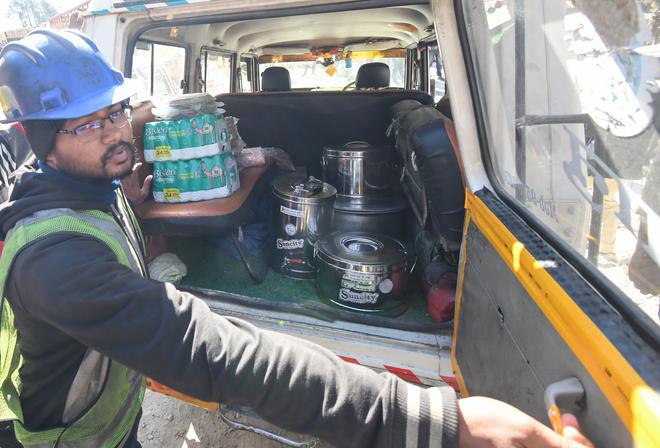The 41 workers stuck in a collapsed tunnel in Uttarakhand’s Silkyara are likely to see sunlight on Thursday, for the first time since they were trapped on November 12, according to rescue teams working round the clock to create an escape route. By 5 p.m. on Wednesday evening, agencies had managed to drill through 45 metres of debris in a bid to reach the workers trapped between the 53- and 59-metre mark.
However, the rescue work, which picked up pace over the last 36 hours was halted late on Wednesday evening when the auger machine used to bore through debris struck an obstacle, reportedly a giant rock. The operation was delayed as agencies mulled the best way to remove the obstacle. Agencies are also taking multiple other approaches from both sides of the tunnel to reach the workers, to provide alternate options if needed.
Chief Minister Pushkar Singh Dhami has reached Uttarkashi, aiming to meet the workers as soon they are able to exit the collapsed tunnel. “If all goes as planned, there will be a good news for everyone on Thursday,” senior Uttarakhand government official Bhaskar Khulbe said in a media briefing on Wednesday evening.
Preparing for rescue
A mock drill was conducted late in the evening to ensure that the final phase of the rescue goes smoothly. An ambulance is being kept on standby to ferry the trapped workers to a temporary hospital set up to ensure immediate medical help for them.
An audio communication system was set up to speak to the trapped workers on Wednesday, said Uttarakhand Secretary Neeraj Khairwal, allowing consultations with medical personnel. The workers each spoke to a doctor, and essential medicines were sent to them, along with basic necessities such as towels, brushes, and clothes. “Keeping in mind the mental health of the workers, they are also being made to talk to a psychiatrist. All the workers trapped inside are safe,” he added.
Also read: Uttarkashi tunnel rescue | Families hope to find light at the end of the tunnel
Working on plan B
Rescue teams from various agencies are also working on a plan B. Apart from horizontal drilling through the debris, vertical drilling is being done simultaneously at the side by a rescue team from the Satluj Jal Vidyut Nigam (SJVNL), according to Mahmood Ahmed, managing director of National Highways & Infrastructure Development Corporation Limited (NHIDCL), which was constructing the tunnel.
He added that another agency, THDC India, has also initiated the construction of a rescue tunnel from the Barkot end, with four blasts already completed, resulting in a 9.10 metre drift. “Efforts are being made to carry out three blasts per day,” he said.
Drilling from both sides
In another attempt to rescue the trapped workers, perpendicular horizontal drilling is also being continued by Rail Vikas Nigam Limited (RVNL). The vertical drilling towards the Barkot end is being done by the Oil and Natural Gas Corporation (ONGC) which has mobilised machinery from Mumbai, Ghaziabad, and the United States to carry out vertical boring.
Work is also underway to create a drift inside the tunnel, with a safe channel established from 180 metres to 150 metres. The Army is mobilising box culverts for this purpose, and the fabrication of eight frames have been completed, with the work being done jointly by teams from the Army, THDC, Coal India, and NHIDCL.

The Border Roads Organisation has already completed the construction of an approach road for the vertical drilling being done by SJVNL and RVNL, and is also building an approach road for ONGC.
On November 12, a collapse occurred in the under-construction tunnel from Silkyara to Barkot due to debris falling in a 60-metre stretch on the Silkyara side, trapping 41 labourers inside. Rescue teams initially opted to drill a 900 mm pipe through the debris, but safety concerns led to the exploration of multiple rescue options simultaneously. The area of entrapment, measuring 8.5 metres in height and 2 kilometres in length, is in the built-up portion of the tunnel, meaning that the workers are relatively safe and have access to the electricity and water supply.







